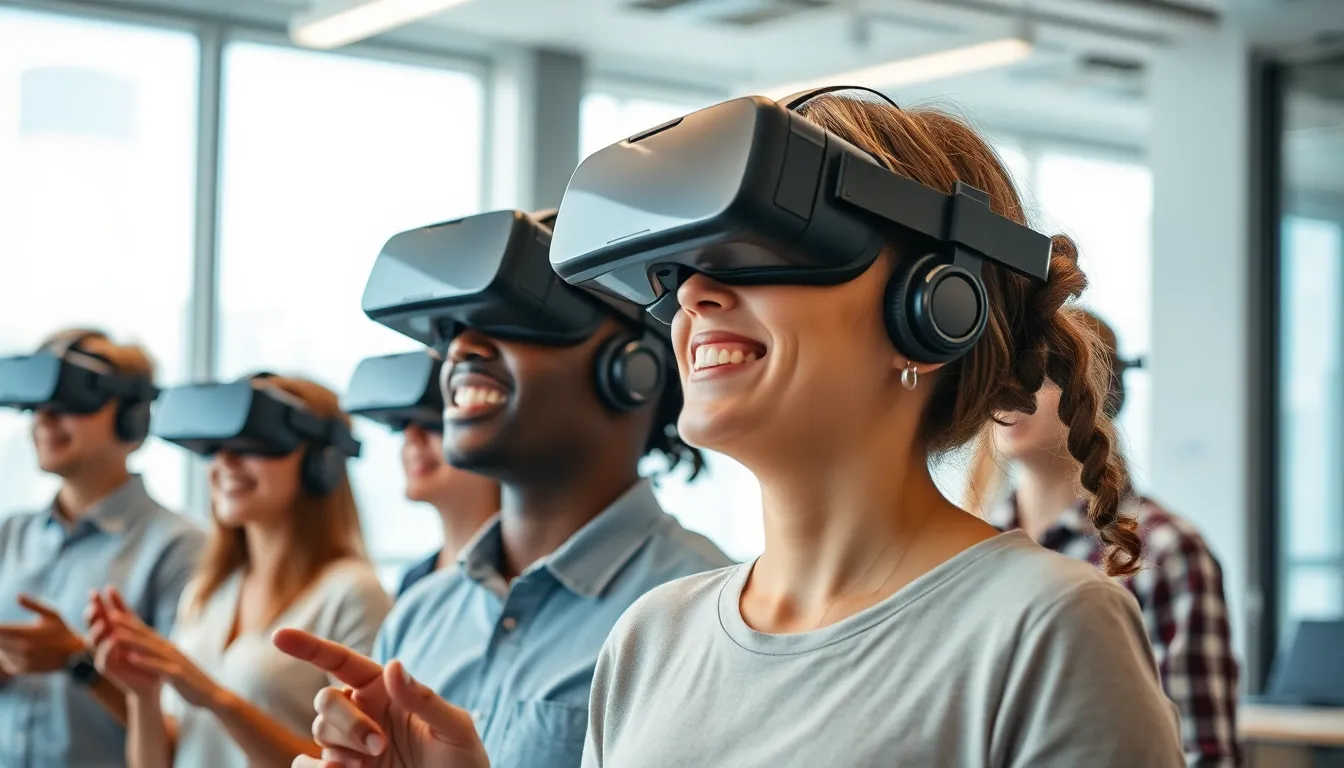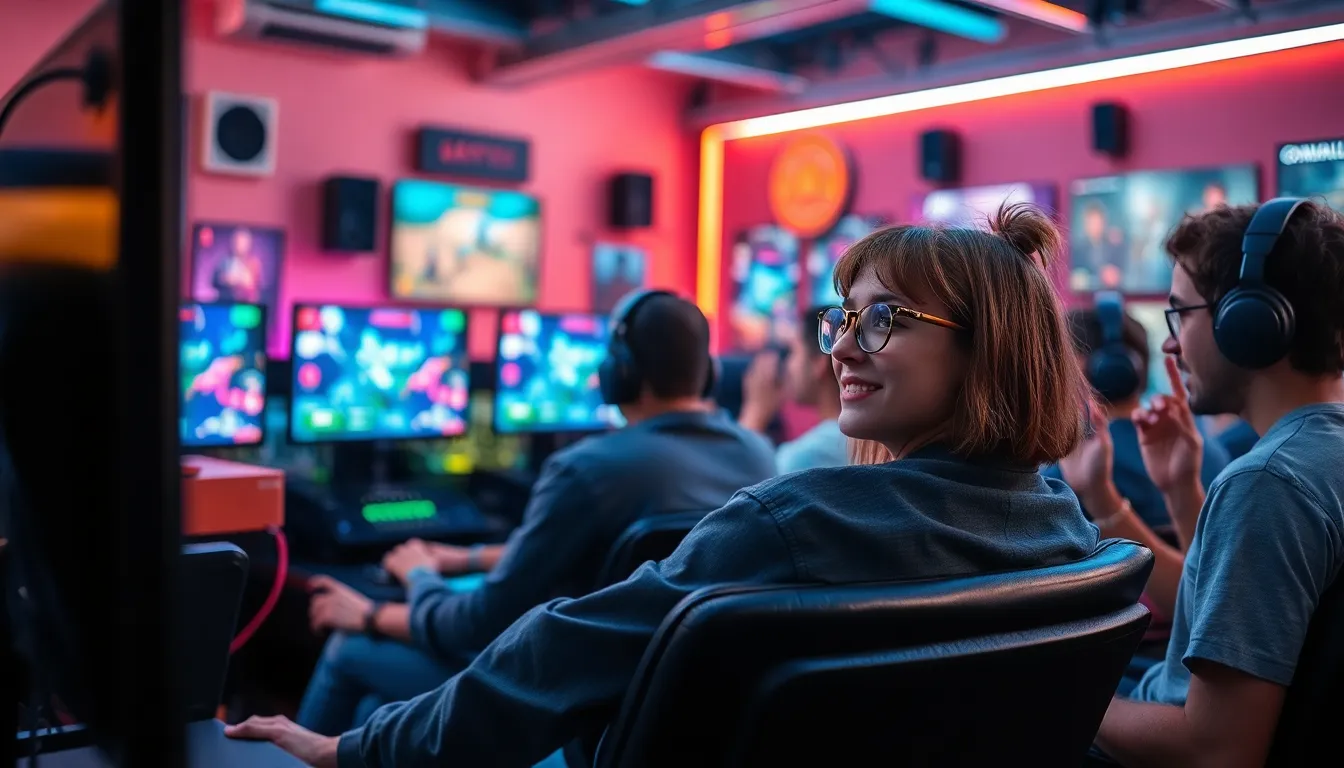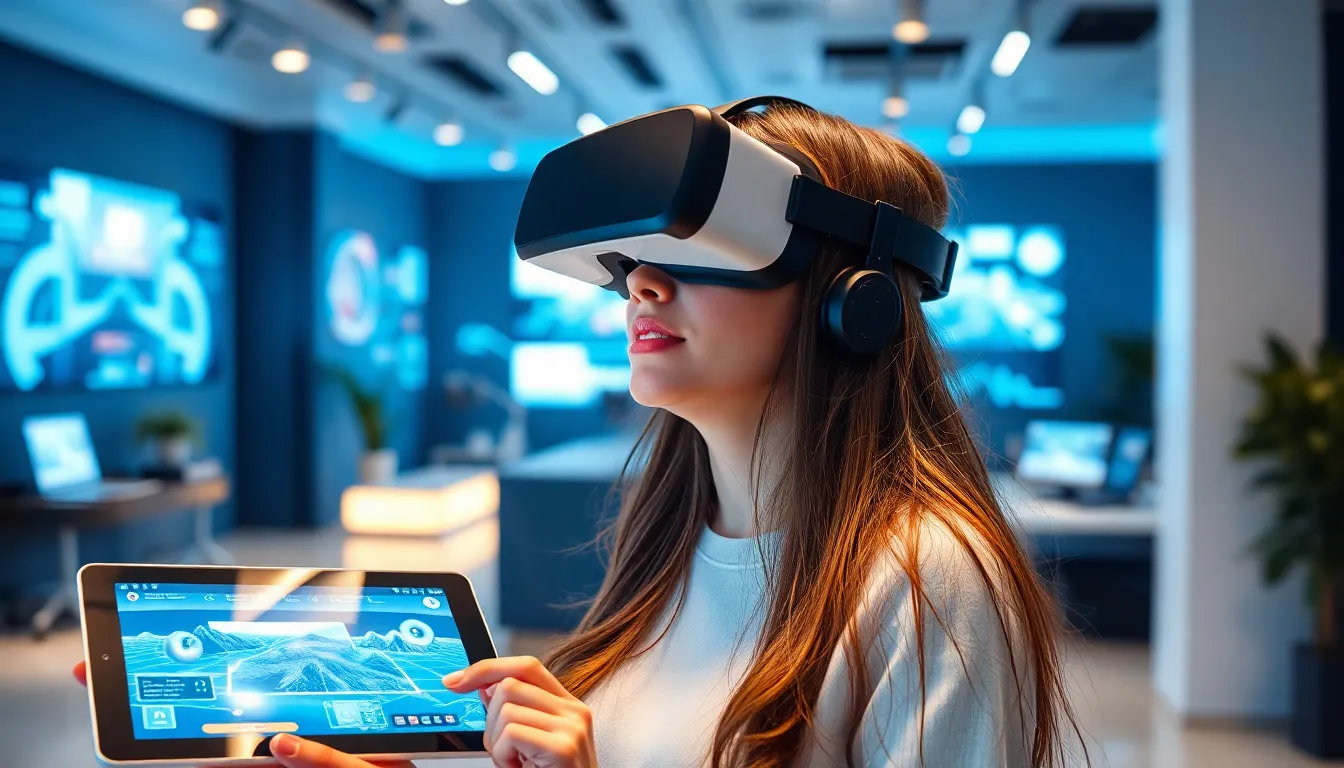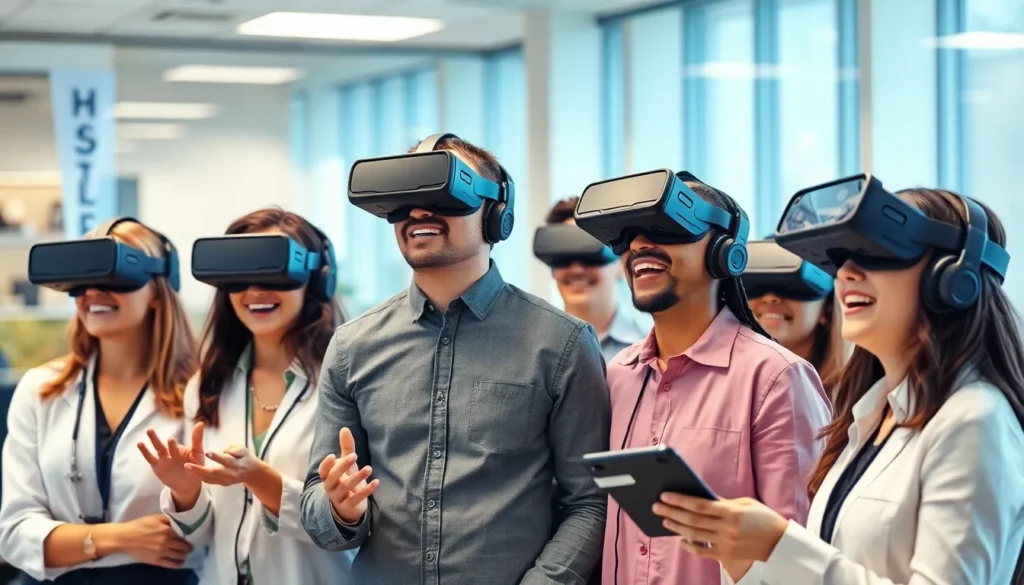Table of Contents
ToggleImagine slipping on a pair of glasses that can transport you to a world where unicorns roam freely and meetings are held in outer space. Welcome to the global AR-VR market, where reality is just a suggestion and imagination knows no bounds. As technology evolves faster than a cat meme goes viral, augmented and virtual reality are not just for gamers anymore; they’re reshaping industries from healthcare to education.
Overview of the Global AR-VR Market
The global AR-VR market shows rapid growth, fueled by increasing adoption across industries. In 2023, the market size approached $30 billion, illustrating a significant rise from previous years. Analysts project a compound annual growth rate (CAGR) of around 43.8% from 2023 to 2030. Major sectors adopting these technologies include retail, healthcare, and education.
Consumer demand drives innovations in AR-VR applications. Enhanced user experiences engage customers, leading retailers to implement AR in shopping experiences. For instance, virtual try-on solutions help consumers visualize products before purchase. Additionally, healthcare professionals harness AR simulations for training and patient interactions.
Investment in AR-VR has surged, attracting substantial venture capital funding. Notable tech companies like Meta, Google, and Microsoft are at the forefront of these developments. They are focusing on hardware and software solutions that enhance user experience.
Geographically, North America leads the AR-VR market, primarily due to technological advancements and widespread adoption. However, the Asia-Pacific region is emerging quickly, with countries like China and Japan investing heavily in AR-VR technologies for various applications.
Challenges persist, including high costs and the need for advanced infrastructure. As the technology matures, these barriers are likely to diminish, allowing broader accessibility. Continuous advancements in 5G and improved hardware will further enhance AR-VR capabilities across various sectors.
Key Trends in the Global AR-VR Market

The global AR-VR market showcases significant developments driven by various trends. Emerging technologies continue to reshape how these immersive experiences are created and consumed.
Emerging Technologies
Innovations in hardware and software define the landscape of AR-VR technologies. The advancement of head-mounted displays enhances user experience, offering greater immersion. Cloud computing plays a crucial role, providing the processing power that AR-VR applications require. Also, artificial intelligence integration enables more interactive and realistic environments. This combination of technologies contributes to the evolution of AR-VR solutions across sectors. The development of 5G networks facilitates faster data transmission, which is vital for real-time applications. Enhanced graphics and user interfaces further improve engagement, making these technologies more appealing for consumers.
Market Growth Drivers
Several factors are driving growth in the global AR-VR market. Consumer demand for realistic experiences propels companies to adopt these technologies in various applications. Retailers benefit from AR solutions, particularly in virtual try-on capabilities that increase customer satisfaction. In healthcare, professionals find value in AR simulations for training, significantly improving learning outcomes. Education institutions utilize VR for immersive learning experiences, facilitating better understanding of complex subjects. Investment trends reflect this growth, with major tech companies committing resources to AR-VR development. As companies recognize the potential for improved user engagement, the adoption of AR-VR technologies continues to expand, reinforcing their market presence.
Major Players in the Global AR-VR Market
The global AR-VR market attracts substantial interest from numerous leading companies. These players drive innovation and adoption across industries.
Company Profiles
Meta significantly invests in AR-VR technology, focusing on user experience enhancements. Google emphasizes its ARCore platform, optimizing mobile augmented reality applications. Microsoft targets enterprise solutions through its HoloLens, promoting collaboration and training. Apple joins the race with its ARKit, supporting immersive applications on iOS devices. Other notable companies include Sony and Samsung, both advancing VR gaming and mobile AR offerings.
Competitive Landscape
The competitive landscape features a range of established firms and startups in the AR-VR space. Meta maintains its position as a market leader, benefiting from extensive resources and cutting-edge development. Other key players include Google and Microsoft, both deploying unique strategies to capture market share. Startups increasingly challenge incumbents through innovative approaches and niche offerings. The focus on partnerships and collaborations emerges as crucial for growth. As investment rises, the rivalry intensifies, prompting companies to accelerate product launches and enhance technology capabilities.
Applications of AR-VR Technology
AR-VR technologies are enhancing various sectors by providing immersive experiences and innovative solutions.
Industry-Specific Uses
Healthcare professionals are using AR-VR for surgical simulations, improving medical training effectiveness. Retailers have adopted virtual try-on solutions, increasing customer engagement and satisfaction rates. Education institutions utilize VR for immersive learning environments, promoting retention of complex concepts. Automotive companies employ AR for design visualization and enhancing safety training modules. Manufacturing industries find value in AR for maintenance and assembly tasks, increasing productivity and reducing errors. Each sector benefits distinctly from tailored applications of AR-VR technologies.
Consumer Market Adoption
Consumers demonstrate a growing interest in AR-VR technologies, particularly in gaming and entertainment. The gaming industry leads the charge, with numerous titles showcasing immersive experiences. Retail consumers increasingly appreciate virtual shopping experiences, offering convenience and personalization. Travel and tourism sectors harness AR for interactive experiences at destinations, enhancing visitor engagement. Educational platforms are also gaining traction, allowing learners to explore new subjects through VR. As familiarity with these technologies grows, consumer engagement rates are expected to rise.
Challenges Facing the Global AR-VR Market
High costs present a significant barrier to widespread AR-VR adoption. Firms often encounter high expenses related to hardware, software, and development. Limited infrastructure in certain regions also affects implementation, hindering growth in emerging markets.
User experience matters immensely, yet technical complexities can complicate that. Many AR-VR experiences require advanced devices, which may not be accessible to all consumers. Furthermore, the learning curve associated with new technologies can deter users from fully engaging.
Regulatory challenges also impact the AR-VR landscape. Compliance with data protection regulations remains a concern as companies gather and utilize user data. Privacy issues create potential legal obstacles that businesses must navigate carefully.
Sustainability poses another challenge. The electronics industry faces scrutiny over environmental impacts, particularly concerning electronic waste generated by AR-VR devices. Companies must prioritize eco-friendly practices to address consumer concerns about sustainability.
Competition remains fierce, making it hard for new entrants to establish themselves. Major players like Meta, Google, and Microsoft dominate, leaving fewer opportunities for startups to gain traction. Differentiating products while keeping pace with technological advancements demands significant investment and innovation.
Public perception influences market growth as well. Misunderstandings about AR-VR capabilities can limit user acceptance. Raising awareness about real-world applications can help bridge the gap between expectation and reality.
Lastly, the necessity for continuous innovation impacts long-term success. Staying ahead in AR-VR technology not only involves hardware improvements but also software enhancements that ensure immersive experiences. Ongoing research and development are crucial for addressing industry challenges and meeting evolving consumer demands.
Future Outlook for the Global AR-VR Market
The global AR-VR market is on track for significant enhancements and expansions. Analysts project market size will reach around $300 billion by 2030, demonstrating a strong compound annual growth rate of approximately 43.8% from 2023 to 2030. Companies are increasingly investing in AR-VR technologies, with major players like Meta, Google, and Microsoft accelerating innovation focused on hardware and software improvements.
Emerging markets are crucial for this growth. The Asia-Pacific region, in particular, shows substantial investment potential. Countries such as China and Japan are leading the way, with initiatives aimed at integrating AR-VR technologies into various sectors. North America currently maintains market leadership, yet competition is intensifying as new players emerge and existing firms innovate.
Innovations in hardware are making these technologies more accessible. Head-mounted displays and advanced software solutions are enhancing user experiences significantly. Furthermore, the implementation of 5G networks will facilitate rapid data transmission, enabling real-time applications that consumers demand.
Incorporating artificial intelligence into AR-VR creates more interactive environments for users. Enhanced realism in consumer experiences drives growth in retail and education, as sectors increasingly leverage immersive technologies. Retailers streamline operations and boost engagement with virtual try-on solutions, while educational institutions employ VR for enriched learning experiences.
Challenges continue to exist, including high costs and regulatory hurdles related to data privacy. However, public interest is rising, particularly in gaming and interactive entertainment. As consumers become more familiar with AR-VR applications, engagement rates are expected to soar, paving the way for further advancements and wider adoption across industries.
The global AR-VR market stands on the brink of a transformative era. With rapid growth and increasing adoption across various sectors the potential for these technologies is immense. As major players continue to innovate the landscape will evolve, offering richer and more immersive experiences.
Despite challenges such as high costs and regulatory hurdles the momentum behind AR-VR remains strong. Enhanced user engagement and consumer demand for realistic experiences will drive further advancements. As industries continue to embrace these technologies the future looks bright for AR-VR applications worldwide.







